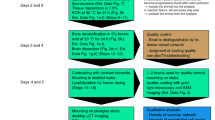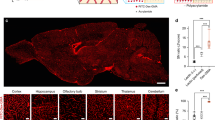Abstract
What is the nature of the vascular architecture in the cortex that allows the brain to meet the energy demands of neuronal computations? We used high-throughput histology to reconstruct the complete angioarchitecture and the positions of all neuronal somata of multiple cubic millimeter regions of vibrissa primary sensory cortex in mouse. Vascular networks were derived from the reconstruction. In contrast with the standard model of cortical columns that are tightly linked with the vascular network, graph-theoretical analyses revealed that the subsurface microvasculature formed interconnected loops with a topology that was invariant to the position and boundary of columns. Furthermore, the calculated patterns of blood flow in the networks were unrelated to location of columns. Rather, blood sourced by penetrating arterioles was effectively drained by the penetrating venules to limit lateral perfusion. This analysis provides the underpinning to understand functional imaging and the effect of penetrating vessels strokes on brain viability.
This is a preview of subscription content, access via your institution
Access options
Subscribe to this journal
Receive 12 print issues and online access
$209.00 per year
only $17.42 per issue
Buy this article
- Purchase on Springer Link
- Instant access to full article PDF
Prices may be subject to local taxes which are calculated during checkout








Similar content being viewed by others
References
Magistretti, P.J. & Pellerin, L. Cellular mechanisms of brain energy metabolism and their relevance to functional brain imaging. Philos. Trans. R. Soc. Lond. B Biol. Sci. 354, 1155–1163 (1999).
Attwell, D. & Laughlin, S.B. An energy budget for signaling in the grey matter of the brain. J. Cereb. Blood Flow Metab. 21, 1133–1145 (2001).
Mchedlishvili, G. Arterial Behavior and Blood Circulation in the Brain (Consultants Bureau, New York, 1963).
Schaffer, C.B. et al. Two-photon imaging of cortical surface microvessels reveals a robust redistribution in blood flow after vascular occlusion. PLoS Biol. 4, 22 (2006).
Blinder, P., Shih, A.Y., Rafie, C.A. & Kleinfeld, D. Topological basis for the robust distribution of blood to rodent neocortex. Proc. Natl. Acad. Sci. USA 107, 12670–12675 (2010).
Devor, A. et al. Suppressed neuronal activity and concurrent arteriolar vasoconstriction may explain negative blood oxygenation level–dependent signaling. J. Neurosci. 27, 4452–4459 (2007).
Derdikman, D., Hildesheim, R., Ahissar, E., Arieli, A. & Grinvald, A. Imaging spatiotemporal dynamics of surround inhibition in the barrels somatosensory cortex. J. Neurosci. 23, 3100–3105 (2003).
Gorelick, P.B. et al. Vascular contributions to cognitive impairment and dementia: a statement for healthcare professionals from the American Heart Association/American Stroke Association. Stroke 42, 2672–2713 (2011).
Iadecola, C. Neurovascular regulation in the normal brain and in Alzheimer's disease. Nat. Rev. Neurosci. 5, 347–360 (2004).
Cauli, B. et al. Cortical GABA interneurons in neurovascular coupling: relays for subcortical vasoactive pathways. J. Neurosci. 24, 8940–8949 (2004).
Attwell, D. & Iadecola, C. The neural basis of functional brain imaging signals. Trends Neurosci. 25, 621–625 (2002).
Weber, B., Keller, A.L., Reichold, J. & Logothetis, N.K. The microvascular system of the striate and extrastriate visual cortex of the macaque. Cereb. Cortex 18, 2318–2330 (2008).
Grinvald, A., Lieke, E.E., Frostig, R.D., Gilbert, C.D. & Wiesel, T.N. Functional architecture of cortex revealed by optical imaging of intrinsic signals. Nature 324, 361–364 (1986).
Woolsey, T.A. & Van Der Loos, H. The structural organization of layer IV in the somatosensory region (SI) of mouse cerebral cortex. Brain Res. 17, 205–242 (1970).
Woolsey, T.A. et al. Neuronal units linked to microvascular modules in cerebral cortex: response elements for imaging the brain. Cereb. Cortex 6, 647–660 (1996).
Nishimura, N., Schaffer, C.B., Friedman, B., Lyden, P.D. & Kleinfeld, D. Penetrating arterioles are a bottleneck in the perfusion of neocortex. Proc. Natl. Acad. Sci. USA 104, 365–370 (2007).
Nishimura, N., Rosidi, N.L., Iadecola, C. & Schaffer, C.B. Limitations of collateral flow after occlusion of a single cortical penetrating arteriole. J. Cereb. Blood Flow Metab. 30, 1914–1927 (2010).
Drew, P.J. et al. Chronic optical access through a polished and reinforced thinned skull. Nat. Methods 7, 981–984 (2010).
Tsai, P.S. et al. Correlations of neuronal and microvascular densities in murine cortex revealed by direct counting and colocalization of cell nuclei and microvessels. J. Neurosci. 29, 14553–14570 (2009).
Tsai, P.S. et al. All-optical histology using ultrashort laser pulses. Neuron 39, 27–41 (2003).
Shih, A.Y. et al. The smallest stroke: occlusion of one penetrating vessel leads to infarction and a cognitive deficit. Nat. Neurosci. 16, 55–63 (2013).
Nguyen, J., Nishimura, N., Fetcho, R.N., Iadecola, C. & Schaffer, C.B. Occlusion of cortical ascending venules causes blood flow decreases, reversals in flow direction, and vessel dilation in upstream capillaries. J. Cereb. Blood Flow Metab. 31, 2243–2254 (2011).
Kim, T. & Kim, S.G. Temporal dynamics and spatial specificity of aterial and venous blood volume changes during visual stimulation: implication for BOLD quantification. J. Cereb. Blood Flow Metab. 31, 1211–1222 (2011).
Frostig, R.D., Lieke, E.E., Ts'o, D.Y. & Grinvald, A. Cortical functional architecture and local coupling between neuronal activity and the microcirculation revealed by in vivo high-resolution optical imaging of intrinsic signals. Proc. Natl. Acad. Sci. USA 87, 6082–6086 (1990).
Kaufhold, J.P., Tsai, P.S., Blinder, P. & Kleinfeld, D. Vectorization of optically sectioned brain microvasculature: learning aids completion of vascular graphs by connecting gaps and deleting open-ended segments. Med. Image Anal. 16, 1241–1258 (2012).
Lauwers, F., Cassot, F., Lauwers-Cances, V., Puwanarajah, P. & Duvernoy, H. Morphometry of the human cerebral cortex microcirculation: general characteristics and space-related profiles. Neuroimage 39, 936–948 (2008).
Hirsch, S., Reichold, J., Schneider, M., Székely, G. & Weber, B. Topology and hemodynamics of the cortical cerebrovascular system. J. Cereb. Blood Flow Metab. 32, 952–967 (2012).
Duvernoy, H.M., Delon, S. & Vannson, J.L. Cortical blood vessels of the human brain. Brain Res. Bull. 7, 519–579 (1981).
Nishimura, N. et al. Targeted insult to individual subsurface cortical blood vessels using ultrashort laser pulses: three models of stroke. Nat. Methods 3, 99–108 (2006).
Shih, A.Y. et al. Active dilation of penetrating arterioles restores red blood cell flux to penumbral neocortex after focal stroke. J. Cereb. Blood Flow Metab. 29, 738–751 (2009).
Cserti, J. Application of the lattice Green's function for calculating the resistance of infinite networks of resistors. Am. J. Phys. 68, 896–913 (2000).
Pries, A.R., Secomb, T.W., Gaehtgens, P. & Gross, J.F. Blood flow in microvascular networks. Experiments and simulation. Circ. Res. 67, 826–834 (1990).
Wu, F.Y. Theory of resistor networks: the two-point resistance. J. Phys. A Math. Gen. 37, 6653 (2004).
Newman, M.E.J. Modularity and community structure in networks. Proc. Natl. Acad. Sci. USA 103, 8577–8582 (2006).
Mayhan, W.G. & Heistad, D.D. Role of veins and cerebral venous pressure in disruption of the blood-brain barrier. Circ. Res. 59, 216–220 (1986).
Grinvald, A., Frostig, R.D., Siegel, R.M. & Bartfeld, E. High-resolution optical imaging of functional brain architecture in the awake monkey. Proc. Natl. Acad. Sci. USA 88, 11559–11563 (1991).
Bonhoeffer, T. & Grinvald, A. The layout of Iso-orientation domains in area 18 of cat visual cortex: optical imaging reveals a pinwheel-like organization. J. Neurosci. 13, 4157–4180 (1993).
Vazquez, A.L., Fukuda, M. & Kim, S.G. Evolution of the dynamic changes in functional cerebral oxidative metabolism from tissue mitochondria to blood oxygen. J. Cereb. Blood Flow Metab. 32, 745–758 (2012).
Chen-Bee, C.H., Agoncillo, T., Xiong, Y. & Frostig, R.D. The triphasic intrinsic signal: implications for functional imaging. J. Neurosci. 27, 4572–4586 (2007).
Sirotin, Y.B., Hillman, E.M., Bordier, C. & Das, A. Spatiotemporal precision and hemodynamic mechanism of optical point spreads in alert primates. Proc. Natl. Acad. Sci. USA 106, 18390–18395 (2009).
Eppihimer, M.J. & Lipowsky, H.H. Effects of leukocyte-capillary plugging on the resistance to flow in the microvasculature of cremaster muscle for normal and activated leukocytes. Microvasc. Res. 51, 187–201 (1996).
Nakai, K. et al. Microangioarchitecture of rat parietal cortex with special reference to vascular “sphincters”: scanning electron microscopic and dark field microscopic study. Stroke 12, 653–659 (1981).
Boas, D.A., Jones, S.R., Devor, A., Huppert, T.J. & Dale, A.M. A vascular anatomical network model of the spatio-temporal response to brain activation. Neuroimage 40, 1116–1129 (2008).
Guibert, R., Fonta, C. & Plouraboué, F. Cerebral blood flow modeling in primate cortex. J. Cereb. Blood Flow Metab. 30, 1860–1873 (2010).
Risser, L., Plouraboue, F., Cloetens, P. & Fonta, C. A 3D-investigation shows that angiogenesis in primate cerebral cortex mainly occurs at capillary level. Int. J. Dev. Neurosci. 27, 185–196 (2009).
Kleinfeld, D. et al. A guide to delineate the logic of neurovascular signaling in the brain. Front. Neuroenergetics 1, 1–9 (2011).
Attwell, D. et al. Glial and neuronal control of brain blood flow. Nature 468, 232–243 (2010).
Zhang, S. & Murphy, T.H. Imaging the impact of cortical microcirculation on synaptic structure and sensory-evoked hemodynamic responses in vivo. PLoS Biol. 5, e119 (2007).
Smith, E.E., Schneider, J.A., Wardlaw, J.M. & Greenberg, S.M. Cerebral microinfarcts: the invisible lesions. Lancet Neurol. 11, 272–282 (2012).
Brundel, M., de Bresser, J., van Dillen, J.J., Kappelle, L.J. & Biessels, G.J. Cerebral microinfarcts: a systematic review of neuropathological studies. J. Cereb. Blood Flow Metab. 32, 425–436 (2012).
Kohn, A., Metz, C., Quibrera, M., Tommerdahl, M.A. & Whitsel, B.L. Functional neocortical microcircuitry demonstrated with intrinsic signal optical imaging in vitro. Neuroscience 95, 51–62 (2000).
Denk, W., Strickler, J.H. & Webb, W.W. Two-photon laser scanning fluorescence microscopy. Science 248, 73–76 (1990).
Oraevsky, A. et al. Plasma mediated ablation of biological tissues with nanosecond-to-femtosecond laser pulses: relative role of linear and nonlinear absorption. IEEE J. Sel. Top. Quantum Electron. 2, 801–809 (1996).
Nguyen, Q.-T., Tsai, P.S. & Kleinfeld, D. MPScope: a versatile software suite for multiphoton microscopy. J. Neurosci. Methods 156, 351–359 (2006).
Emmenlauer, M. et al. XuvTools: free, fast and reliable stitching of large 3D datasets. J. Microsc. 233, 42–60 (2009).
Blondel, V.D., Guillaume, J.-L., Lambiotte, R. & Lefebvre, E. Fast unfolding of communities in large networks. J. Stat. Mech. published online, doi:10.1088/1742-5468/2008/10/P10008 (9 October 2008).
Fortunat, S. Community detection in graphs. Phys. Rep. 486, 74–175 (2010).
Strehl, A. & Ghosh, J. Cluster ensembles: a knowledge reuse framework for combining multiple partitions. J. Mach. Learn. Res. 3, 583–617 (2001).
Watts, D.J. & Strogatz, S.H. Collective dynamics of 'small-world' networks. Nature 393, 440–442 (1998).
Newman, M. Networks: An Introduction (Oxford University Press, New York, 2010).
Acknowledgements
We thank J. Lee for assistance in the analysis of the surface vasculature, J.D. Driscoll for assistance with the imaging acquisition software, N. Nishimura and C.B. Schaffer for sharing their data logs, S. Chien, W. Denk, P.J. Drew, A.L. Fairhall, B. Friedman, R.D. Frostig, H.J. Karten, H.S. Seung, T.W. Secomb, A.Y. Shih and B. Weber for critical discussions. This work was supported by the Israeli Science Foundation (Bikura fellowship to P.B.) and the US National Institutes of Health (grants EB003832, MH085499, MH072570 and OD006831).
Author information
Authors and Affiliations
Contributions
P.B., D.K. and P.S.T. designed the study. P.B., P.M.K. and P.S.T. carried out the experiments and analyzed and summarized the data with input from J.P.K., D.K. and H.S. D.K. wrote the manuscript.
Corresponding author
Ethics declarations
Competing interests
The authors declare no competing financial interests.
Rights and permissions
About this article
Cite this article
Blinder, P., Tsai, P., Kaufhold, J. et al. The cortical angiome: an interconnected vascular network with noncolumnar patterns of blood flow. Nat Neurosci 16, 889–897 (2013). https://doi.org/10.1038/nn.3426
Received:
Accepted:
Published:
Issue Date:
DOI: https://doi.org/10.1038/nn.3426
This article is cited by
-
Intelligent block copolymer self-assembly towards IoT hardware components
Nature Reviews Electrical Engineering (2024)
-
Direct contribution of the sensory cortex to the judgment of stimulus duration
Nature Communications (2024)
-
Estimates of the permeability of extra-cellular pathways through the astrocyte endfoot sheath
Fluids and Barriers of the CNS (2023)
-
Quantifying the relationship between spreading depolarization and perivascular cerebrospinal fluid flow
Scientific Reports (2023)
-
Deep optoacoustic localization microangiography of ischemic stroke in mice
Nature Communications (2023)



